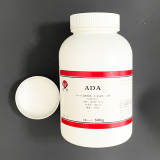Chinese VersionChina Suppliers > Hubei new DE sheng material science and technology co., LTD. > N - (2-acetylamino) -2-iminodiacetic acid ADA
- Search Product
-
-
- Region :China/Hubei
- Tel : +86-18971041571
- Fax :
- Email :vickyzhao@whdschem.com
- URL :
- Add :Guanggu United Science and Technology City C8, Ezhou City, Hubei Province
- Details for N - (2-acetylamino) -2-iminodiacetic acid ADA
-
N - (2-acetylamino) -2-iminodiacetic acid ADA
Category : Others

CAS NO : 26239-55-4 EC NO : 247-530-0 MF : C6H9N2O5 MW : 189.1466 Specification : White Powder Packing : 500g/bottle Product description : Buffers play a crucial role in chemical and biological experiments, as they can stabilize the pH value of the solution, thereby maintaining the stability and accuracy of the reaction system. Among numerous buffering agents, N - (2-acetylamino) -2-iminodiacetic acid (ADA) has attracted much attention due to its unique performance and wide range of applications. ADA buffer, as an amino acid buffer, has excellent stability. It can maintain the stability of the solution within the neutral and weakly acidic pH range, and is not affected by temperature changes and ion concentration. Compared to other buffering agents, ADA is less prone to decomposition during long-term storage and use, ensuring the accuracy and reliability of experimental results. ADA buffer has a wide range of pH regulation, with a pH value of 1.5-3.0 in aqueous solution, indicating acidity. When added to the experimental solution, its high activity range can be between 5.8 and 7.4, suitable for various experimental needs. In biological research, the suitable pH values of many enzymes and proteins fall within the regulatory range of ADA buffer, making it an advantageous buffer for many biological experiments. ADA buffer not only effectively stabilizes the pH value of the solution, but also has good metal ion coordination ability. In some experiments, specific metal ions may interfere with the reaction, and the coordination effect of ADA buffer can stabilize these metal ions, thereby avoiding interference and keeping the experiment undisturbed. It has a wide range of applications in biological experiments, especially in the fields of molecular biology and biochemistry. In experiments, to prevent protein oxidation, ADA can be added to prevent irreversible reactions. At the same time, due to its low dependence on protein, ADA can also be used in cell culture media. Even without protein in the culture medium, ADA can support CEF cell survival and maintain experimental repeatability. Uses : Biological buffer Synonyms : ADA;N-(2-Acetamido)iminodiacetic acid;N-(Carbamoylmethyl)iminodiacetic acid; N-(2-Amino-2-oxoethyl)-N-(carboxymethyl)-glycine;2,2'-[(2-amino-2-oxoethyl)imino]diacetic acid;2,2'-[(2-amino-2-oxoethyl)ammonio]diacetate; Molecular Structure : 
- more>>Other Products
-
- • Biological buffer 3- [N, N-di (hydroxyethyl) amino] -2-hydroxypropanesulfonic acid DIPSO
- • Luminol Sodium Salt
- • 4-Aminophthalhydrazide
- • acridinium ester DMAE-NHS
- • acridinium ester NSP-DMAE-NHS
- • Acridine hydrochloride NSP-SA
- • Acridine hydrochloride NSP-SA-NHS
- • NSP-SA-ADH
- • acridinium ester ME-DMAE-NHS TOOS; 3-(N-Ethyl-3-Methylanilino)-2-Hydroxypropanesulfonic Acid Sodium Salt
- • TOPS; Sodium 3-(N-Ethyl-3-Methylanilino)Propanesulfonate; N-Ethyl-N-Sulfopropyl-M-Toluidine Sodium Salt
- • ADOS Sodium 3-(Ethyl(3-Methoxyphenyl)Amino)-2-Hydroxypropane-1-Sulfonate Dihydrate
- • ADPS N-Ethyl-N-(3-Sulfopropyl)-3-Methoxyaniline Sodium Salt
- • ALPS N-Ethyl-N-(3-Sulfopropyl)Aniline Sodium Salt; Sodium 3-(Ethyl(Phenyl)Amino)Propane-1-Sulfonate; Sodium
- • DAOS; Sodium 3-((3,5-Dimethoxyphenyl)(Ethyl)Amino)-2-Hydroxypropane-1-Sulfonate
- • HDAOS; N-(2-Hydroxy-3-Sulfopropyl)-3,5-Dimethoxyaniline Sodium Salt
- • MADB N,N-Bis(4-Sulfobutyl)-3,5-Dimethylaniline Disodium Salt
- • MAOS N-Ethyl-N-(2-Hydroxy-3-Sulfopropyl)-3,5-Dimethylaniline Sodium Salt Monohydrate
- • DAB 3,3',4,4'-Biphenyltetramine Tetrahydrochloride